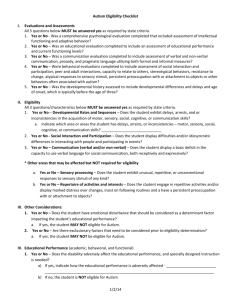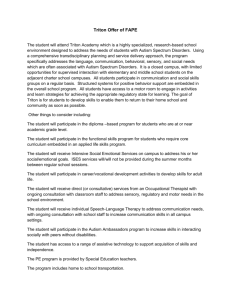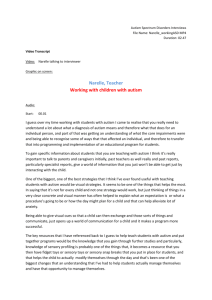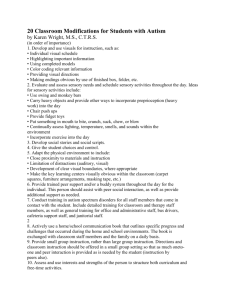Classroom Design for Autism: Creating Supportive Learning Spaces
advertisement
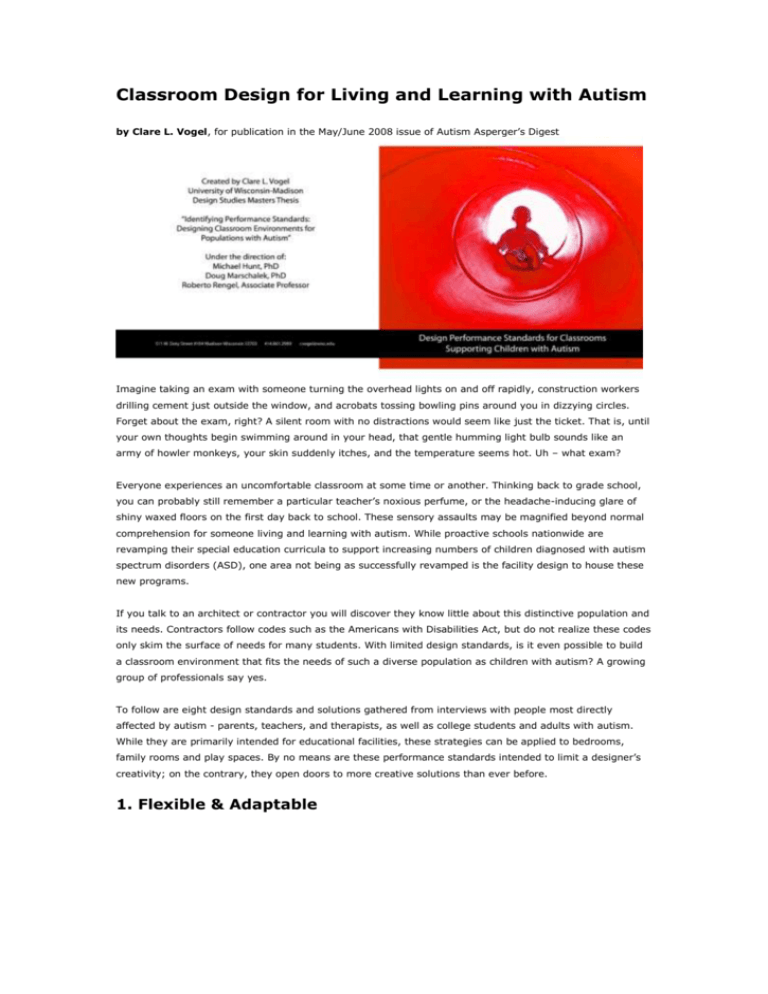
Classroom Design for Living and Learning with Autism by Clare L. Vogel, for publication in the May/June 2008 issue of Autism Asperger’s Digest Imagine taking an exam with someone turning the overhead lights on and off rapidly, construction workers drilling cement just outside the window, and acrobats tossing bowling pins around you in dizzying circles. Forget about the exam, right? A silent room with no distractions would seem like just the ticket. That is, until your own thoughts begin swimming around in your head, that gentle humming light bulb sounds like an army of howler monkeys, your skin suddenly itches, and the temperature seems hot. Uh – what exam? Everyone experiences an uncomfortable classroom at some time or another. Thinking back to grade school, you can probably still remember a particular teacher’s noxious perfume, or the headache-inducing glare of shiny waxed floors on the first day back to school. These sensory assaults may be magnified beyond normal comprehension for someone living and learning with autism. While proactive schools nationwide are revamping their special education curricula to support increasing numbers of children diagnosed with autism spectrum disorders (ASD), one area not being as successfully revamped is the facility design to house these new programs. If you talk to an architect or contractor you will discover they know little about this distinctive population and its needs. Contractors follow codes such as the Americans with Disabilities Act, but do not realize these codes only skim the surface of needs for many students. With limited design standards, is it even possible to build a classroom environment that fits the needs of such a diverse population as children with autism? A growing group of professionals say yes. To follow are eight design standards and solutions gathered from interviews with people most directly affected by autism - parents, teachers, and therapists, as well as college students and adults with autism. While they are primarily intended for educational facilities, these strategies can be applied to bedrooms, family rooms and play spaces. By no means are these performance standards intended to limit a designer’s creativity; on the contrary, they open doors to more creative solutions than ever before. 1. Flexible & Adaptable Flexibility, which can also be thought of as adjustability or adaptability, is the first and most widely agreed upon standard. It seems simple enough. However, defining flexibility in terms of design is more complex than one might imagine, especially since it means different things for different users. In the case of designs for children with autism, flexibility will not mean constant change, but rather being able to transform an environment on a moment’s notice. Furnishings, spatial arrangements and lighting solutions are good places to start since they can contribute to a design that aids in adapting programs to changes in children’s needs. Students should have the option to rearrange and subdivide spaces. When offered flexible furnishings and open-ended materials, children engage in a range of activities that foster their development and learning, become more competent in their physical abilities, and develop self-confidence and independence (Curtis & Cramer, 2003). Rolling shelving units and furniture pieces that are easy to move and can serve multiple purposes are helpful. Look for shelving units that can act as storage spaces, blackboards, and screen partitions. Teachers and students can both benefit from the flexibility and spatial variety that portable screens or dividers offer, instantly creating smaller spaces within larger ones for group or individual work. Try risers or movable platforms that also allow children to create new arrangements. 2. Non-Threatening For a physical space to be non-threatening the layout should feel welcoming and foster encounters, communication, and relationships. Settings should provide restful, restorative places and offer a sense of security. Provide high perching spots (child balconies) and low, enclosed spaces (child caves) above and at floor level, shallow enough so a teacher can monitor children. Consider providing larger spaces for older children so groups can gather. However, those spaces should be flexible and temporarily divisible in case large-group work simply becomes overwhelming (Moore, G. et al, 1979). Use elements that are soft and can provide sensory input, such as beanbag chairs, stuffed couches, carpeting, swings, clay, and water. For children who tend to orbit as a way of maintaining control of their bodies, it is wise to avoid large open spaces, which can easily turn into dead space. 3. Non-Distracting A non-distracting room will be free of clutter, relatively odor-free, and visually and aurally restorative. In other words, the room will decrease sensory overload. The classroom arrangement should contribute to the child’s grasp of order and space. A clean and distinct environment helps the child with autism focus his attention on learning instead of irrelevant stimuli. A woman with Asperger’s Syndrome commented, “Bodies can be drowned out by so much stuff.” Eliminate nonessential visual materials such as posters and disorderly signage, and block out temporary distractions with screens and window shades. Inadequate storage space, a major gripe from most teachers, also makes a room look chaotic and cluttered. Develop storage space outside and inside that doubles as some other architectural feature or furniture element (Curtis & Carter, 2003). To avoid the flickering and humming from fluorescent lights, try reducing the intensity of lights by switching to fewer bulbs, natural light, and homier lamps for task lighting. Finally, block out mechanical noises from old heaters or fans with sound-absorbing carpeting, fabrics, and furnishings. One man with autism who has strong sensitivities to fluorescents and loud noises admitted his needs vary from day to day. “It boils down to how much I can tolerate on any given day.” 4. Predictable Everyone prefers a building that is easy to navigate. Predictability is key, particularly for populations who need consistency and visual cueing. Because children with ASD tend to be visual learners, a frequent solution is pinning up bright schedules, picture boards and labels around the classroom. Teachers unintentionally run the risk of reversing their efforts to make a room less distracting. Instead, they should consider what makes classrooms truly imageable (Lynch, 1964) and legible (Weisman, 1981). When urban planners decide how to arrange a city, various elements are thought to increase both recognition and legibility. These elements also apply to micro-environments like schools. Create evident paths (colored tape or painted footprints), activity pockets (pods of work spaces with various tasks), neighborhood-like districts (named hallways or color-coded zones), bold and memorable edges (murals, half walls or fences) and landmarks (a sculpture, indoor garden or aquarium). Use signs, numbering systems and clear views to build a sense of predictability. Provide users with environmental information through smell, sight, sound and touch, while being cognizant of strong distastes for certain things. Individuals with autism often have trouble multi-tasking. If they are listening intently to something, they might not be able to see, as if only one sense is turned on at once (Grandin, 2007). By offering multiple sensory cues, designers can come closer to insuring all users understand their design. 5. Controllable Predictability is one step towards controllability (Sherrod & Cohen, 1978). When a child can understand his or her environment, emotional security rises and the child feels an increased sense of control. Because children on the autism spectrum have specific social challenges, personal space may be more of a priority than for a typically developing child. Classrooms supporting these children must allow for varied social interactions and provide opportunities for choice-making. All people feel more comfortable and in control when they have a transition zone between private and public spaces. Just as a porch separates the house from the street, a transition space in the form of an alcove or differentiated hallway separates the classroom from the main corridor, providing important environment information from a safe, defensive position. Many adults with ASD reported that having a tight, contained space nearby (such as a closet, or even two vertical mattresses to wedge one’s body between) gave them a sense of control and release. 6. Sensory-Motor Attuned Children tend to have puzzling sensory integration needs and challenges, often ignoring their visual environment. They may need help in directing their attention to sensory information that will allow them to interact more effectively (Ayres, 2005). Sensory-motor needs can fluctuate with age, from person to person, and from day to day in the same child, making it important to plan and fine-tune an environment that is most suitable. Sensory gyms are wonderful for learning and playing, but schools must not stop here. Every environment a child enters at school should provide sensory opportunities for exploration. This also provides sensory experiences for neurotypical children, which as an autism consultant who also has Asperger’s stresses, is “extremely important for classroom inclusion.” An elementary school teacher in Madison, Wisconsin, described a school where she worked previously that did not have a sensory room. “You had to go outside to do swinging or to run. There’s not always that luxury (to go outside)…we used a wheelchair ramp that was in the school and we would move up and down the wheelchair ramp doing relay races. It’s much better to have a space designed for that because kids get more used to it.” A special education teacher in Hustisford, Wisconsin, built a calm room “where kids knew they could have their meltdowns.” Numerous sensory experiences exist that can be created and tailored with a variety of textures and flooring materials, sensory tables filled with interesting objects, scratchy surfaces or music. 7. Safe For children with autism, creating a safe environment can be a challenge. Designers and teachers need to pay attention to both physical hazards (wiring, open stairways, unscreened windows, loose flooring, toxic paints, etc.) and emotional safety and security. Children with ASD are often prone to seizures and behaviors like tantrums or “stimming,” where injury to self and others can occur. A Madison-based speech language pathologist thinks of safety “not in the sense of being sterile, but in being challenging but safe, eliminating, or at least reducing, the need for a lot of rules.” Transparency in windows and doorways is another method of easing transitions and making a child feel safe. For youngsters, this provides a place to wave goodbye to parents; for older students, transparency provides a sense of protection when they know others can see them. Soft surfaces can reduce the potential for injury; though beware of chemicals, odors and off-gassing in surfaces such as foam or carpeting. Lastly, small, enclosed spaces tend to enhance feelings of closeness, intimacy, and safety. An occupational therapist in Madison says “Some kids start off a lot better in smaller spaces like a tent, with as little in the space as possible, just a few choice items.” Individual and small-group workstations should provide a certain amount of privacy. 8. Non-Institutional Feeling truly at home in their surroundings will allow children to relax and retain more information. Classrooms designed with catalog furniture are often sterile or the opposite - overstimulating. Such environments can also remind students all too much of the clinical settings at doctors’ offices. Adding softer lighting and home furnishings, even for storage cabinets and other functional equipment, can offset this feeling. Colors suited for homes (warmer hues, skin tones and pastels), soft furnishings, interesting textures, thoughtfully placed works of art, and plants and objects from the natural world can turn a conventional classroom into a cozy, community gathering place. If a time-out center is needed, think of alternative environments such as a small tent or fort rather than a sterile office setting. Essentially, a noninstitutional school embraces all seven of the other design performance standards previously listed. There is no perfect design treatment for autism, just as there is no perfect set of dietary restrictions, medications or therapies. However, professional designers, school administrators, classroom teachers and parents can learn much from user experts in identifying attributes of a supportive, “least restrictive” environment. It is indeed both practical and hopeful to believe that good design for students with special needs is good design for all. References Ayres, A.J. (2005). (reprint) Sensory integration and the child: Understanding hidden sensory challenges. Los Angeles, CA: Western Psychological Services. Curtis, D., Carter, M. (2003). Designs for living and learning: Transforming early childhood environments. St. Paul, MN: Redleaf Press. Grandin, T. (2007). Lecture PowerPoint Handouts, Milwaukee, WI. Lynch, K. (1960). The image of the city. Cambridge: M.I.T. Press. Merritt, E., Beaudin, J., Cassidy, C., Myler, P. (2005). Magnet and specialized schools of the future: A focus on change. Chapter 6. Lanham, Maryland: Fletcher-Thompson, Inc. and Scarecrow Education. Moore, Cohen, Oertel, van Ryzin. (1979). Designing environments for handicapped children. (pp. 15-51). NY: Publishing Center for Cultural Resources. Moore, G., Lane, C., Hill, A., Cohen, U., McGinty, T. (1979). Recommendations for child care centers. Children’s Environment Project, Center for Architecture and Urban Planning Research. University of WI – Milwaukee. Sherrod & Cohen. (1978). When density matters: Environmental control as a determinant of crowding effects in laboratory and residential settings. Population & Environment. (pp. 189-202) Vol. 1, Number 3/September 1978. Weisman, G. (1981). Evaluating architectural legibility – way finding in the built environment. Environment and Behavior.


